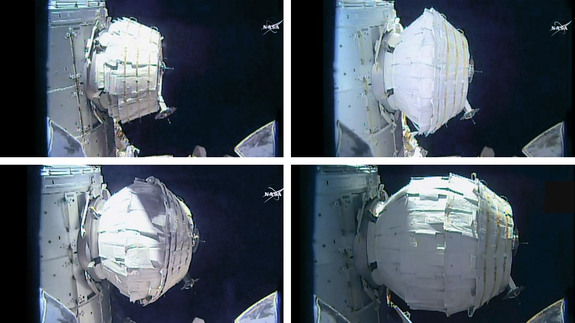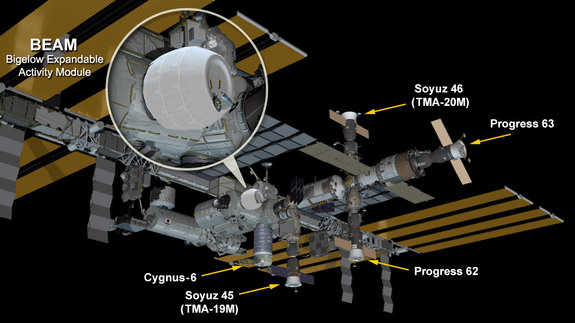
The Bigelow Expandable Activity Module is seen fully inflated on the International Space Station after being successfully expanded to its full size on May 28, 2016. The Bigelow Aerospace-built BEAM is a prototype space habitat for future space stations, moon colonies and moon bases.
Credit: NASA TV
Houston, you have an epic balloon room in space. NASA has inflated the first-ever expandable room for astronauts on the International Space Station, a round module that made occasional popcorn-like popping sounds as it reached its full size.
It took NASA astronaut Jeff Williams on the station more than seven hours to inflate the privately built Bigelow Expandable Activity Module today (May 28). The new space room, called BEAM for short, was built for NASA by Bigelow Aerospace. Its inflation went at a glacial pace — a safety precaution since BEAM is the first of its kind — with Williams reporting that he heard popping noises with almost every short burst of air he fed into the module through a manual valve.
“It sounds sort of like popcorn in a frying pan starts up,” Williams said. Flight controllers at NASA’s Mission Control center in Houston said the sound was expected and a welcome one, since it indicated BEAM was expanding as planned. [The Inflatable BEAM Space Room in Pictures ]
#BEAM out: First human-rated expandable habitat inflated on @Space_Station : https://t.co/nD0UwbFB48 @BigelowSpace pic.twitter.com/DlJg2O8Bq6
— collectSPACE (@collectSPACE) May 28, 2016
The inflation process began in earnest Saturday at 9:04 a.m. EDT (1304 GMT) and was complete by 4:34 p.m. EDT (2034 GMT). Ten minutes later, the ball-shaped room was pressurized to match the pressure of the rest of the International Space Station.
NASA and Bigelow Aerospace initially tried to inflate the BEAM module on Thursday (May 26), but the expansion process did not go as expected . During that first two-hour attempt, NASA engineers detected higher-than-expected pressures inside the BEAM habitat, but later determined it was likely due to the module’s fabric layers sticking together.

The inflation of the Bigelow Expandable Activity Module, a prototype space habitat, is shown in this series of images taken by a NASA camera on the International Space Station during expansion operations on May 28, 2016. The process took over seven hours.
Credit: NASA TV
The fully inflated BEAM module is 13 feet (4 meters) long and 10.5 feet (3.2 m) wide, and contains 565 cubic feet (16 cubic m) of living space. But at launch, it was compressed into a space 7 feet long by 8 feet wide (2.1 by 2.4 m).
“Congratulations to the entire BEAM team,” Bigelow Aerospace representatives wrote on Twitter after the inflation . “A significant milestone has been accomplished.”
BEAM is a prototype space habitat that can be folded up like a parachute and reduced to nearly one-fifth its inflated size, making it easier to pack for a trip into space. Expandable habitats take up less room in a payload fairing than rigid, metal habitats, and are also lighter, which lowers the cost of sending them to space. In 2013, NASA awarded a $17.8 million contract to Bigelow Aerospace to build BEAM for testing at the space station.
“This first test of an expandable module will allow investigators to gauge how well the habitat performs and, specifically, how well it protects against solar radiation, space debris and the temperature extremes of space,” NASA officials said in a statement .

This NASA graphic shows the location of the inflatable Bigelow Expandable Activity Module on the International Space Station. The module will be tested for its effectiveness as a space habitat for two years.
Credit: NASA
With the BEAM inflation complete, NASA and Bigelow Aerospace will begin a weeklong series of leak checks. Only once those leak checks are complete will astronauts be allowed inside BEAM module for the first time, NASA officials have said.
The station crewmembers were initially scheduled to enter the BEAM habitat for the first time on Thursday (June 2), but those plans changed after Thursday’s aborted inflation attempt. The leak checks should take about a week to complete, NASA added.
Congratulations to everyone involved in the BEAM program. A significant milestone has been accomplished pic.twitter.com/xPvQHPFRkS
— Bigelow Aerospace (@BigelowSpace) May 28, 2016
The Las Vegas-based Bigelow Aerospace, has tested its expandable habitats in space , but never with human occupants. The space station crewmembers will enter the habitat several times a year to “retrieve sensor data and assess conditions inside the module,” according to NASA officials, but the crewmembers will not occupy the habitat full time.
Bigelow has said that it would like to put expandable habitats on the moon someday. The company has also said it will send one of its massive B330 modules into orbit in 2020, in cooperation with the private spaceflight provider United Launch Alliance.
BEAM flew to the station in a SpaceX Dragon cargo capsule and arrived on April 10. It will remain on the station for two years, after which it will be jettisoned from the station using the Canadarm2, the robotic arm that can be operated from inside the station. Then, the habitat will fall toward Earth and burn up in the atmosphere.
Follow Calla Cofield @callacofield .Follow us @Spacedotcom , Facebook and Google+ . Original article on Space.com .
Comments are closed.